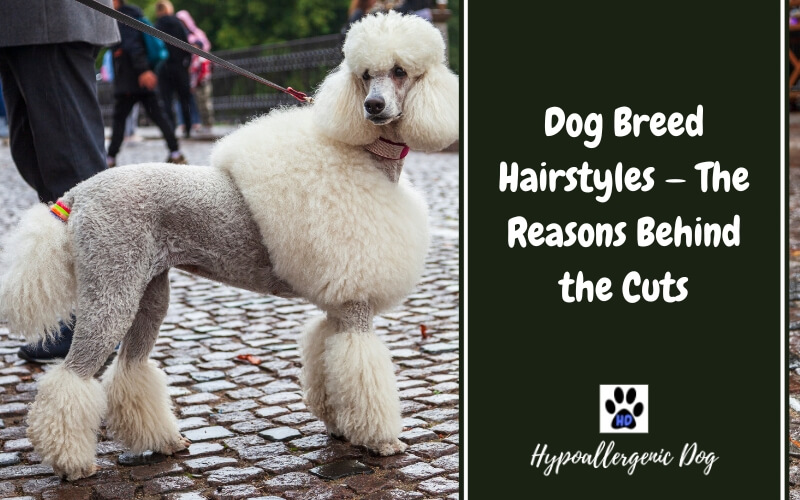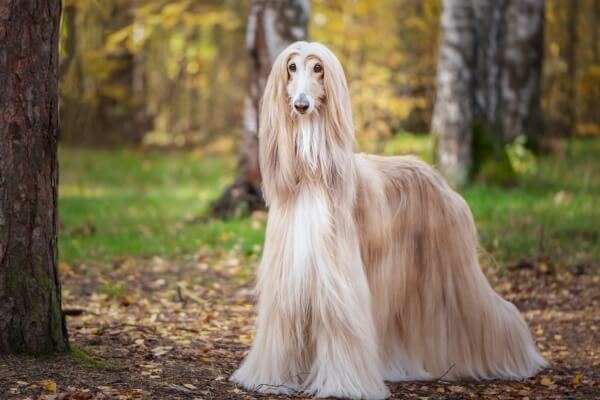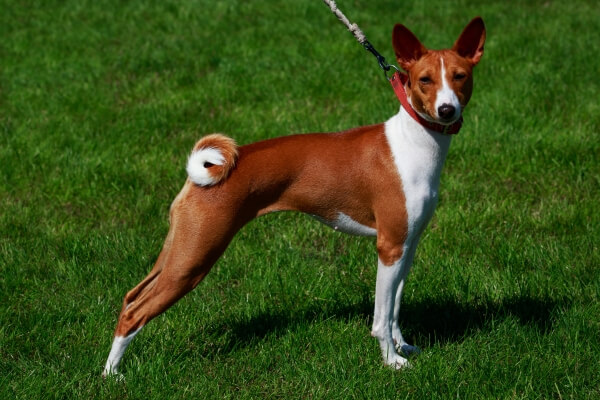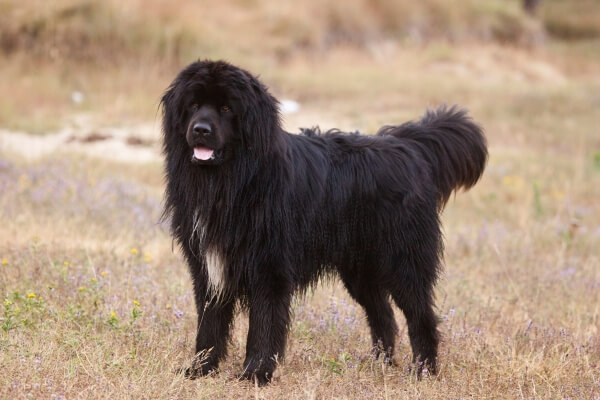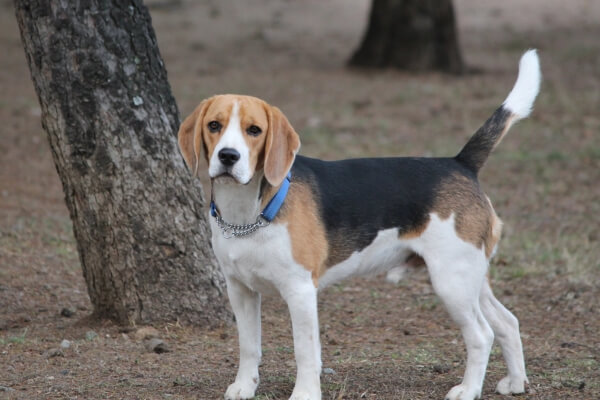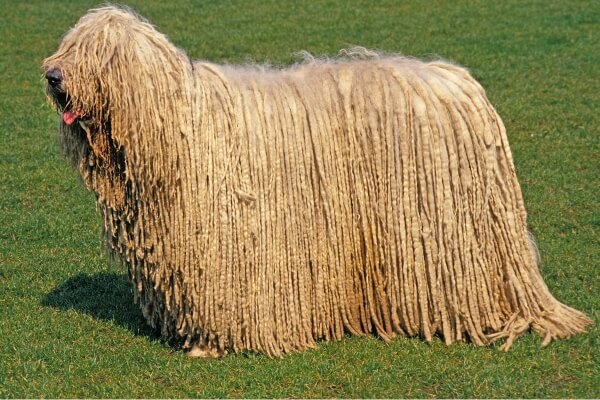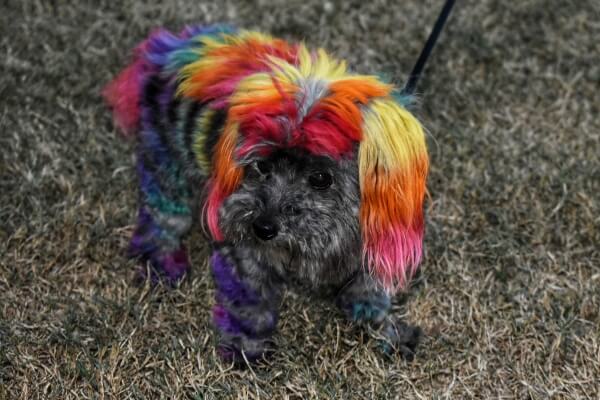From Function to Fashion — The Alarming Facts Behind Dog Breed Hairstyles
So, you go to a dog show — or look at some photos online — and you see the Poodles and Yorkies all done up with their apparently stupid dog breed hairstyles.
What on earth??? you think to yourself.
These aren’t the dogs you have in your home or see in your local park! They’re dolled-up abominations — a humanizing vanity pushed onto the canine by their obviously deranged, Instagram-obsessed, and attention-seeking owners.
But, to be fair, in most circumstances, there are remarkably sensible reasons and justifications for these dog breed cuts.
So, just hold back on your judgments for a little while! Allow me to explain why particular canines sport these unusual trims, how they benefit from having a specific cut, and when some dog styling is never, ever, acceptable.
Dog Breed Hairstyles Contents
How Dog Breed Hair Cuts Are Decided
Example Dog Breed Grooming Styles
The Toxic Trend of Dog Styling
Dog Hairstyling — The Final Cut
How Dog Breed Hair Cuts Are Decided
The Breed Standard Groom
If you go to a dog show, and check out the Afghan Hounds, Yorkshire Terriers, and Portuguese Water Dogs — you’re going to see three completely different grooming styles.
However, within each specific breed group — you’ll see virtually the exact same cut.
This is because strict grooming standards are usually laid out in stone by either breed associations or national kennel clubs. Drawing on the expertise of dog breeders, show judges, and canine experts — they outline the cut requirements for showing the dog.
But, stray from the rules or try to be a grooming maverick, and you and your dog will be ostracized — you’re not going to get yourself a nice rosette.
Admittedly, it makes sense. If all the dogs are presented in the same manner, it’s significantly easier to judge and compare them. Generally speaking, the rules will outline the grooming style and cut, fur color, texture, and coat length.
How the Standards Are Agreed
While individual kennel clubs have their own procedures and tenets for creating grooming standards, generally speaking, they create these rules by trying to remain faithful and sympathetic to the following factors:
- Breed history.
- Breed function.
- Breed class.
- Inherent breed physical traits.
Furthermore, the requirements of the cut can also ensure that the dog breed doesn’t experience any restriction of movement or discomfort — or prevent it from fulfilling its duties in the case of working and sporting dogs.
That said, grooming standards can be fluid — and often the situation can be a complete mess.
As you probably know, I breed Lagottos. And, despite having a history dating back to the 12th century, it’s a relatively new breed to be recognized by the dog authorities — it wasn’t accepted into the AKC until 2015. This means that the requirements for showing the Lagottos are often unclear, misunderstood, and to be honest, a complete shambles.
Let me give you an example:
A friend of mine recently went to a local Lagotto show and returned bewildered. She explained to me how one dog looked like a Bichon Frise, one was presented like a shorn sheep, and another looked as if it had no coat at all.
I said — lemme guess, the one that looked like a Bichon won? She replied, how did you know that? I just said, ah, it’s predictable.
There’s so much ignorance about how Lagottos should be presented. In Italy, their true home, they’re shown rustic. That’s just curly-coated, not fluffed up, and without hairspray. Instead, they look like they’ve just walked into the show ring, want to run around for a bit, and then go up a mountain and find you a truffle.
Hopefully, the authorities will soon see sense and present them as they should be. Grooming standards do evolve and change, and they can even vary somewhat between different kennel clubs.
Example Dog Breed Grooming Styles
Creating dog breed grooming standards that reflect the history of the dog — as well as having functional and practical advantages — leads to a variety of cutting and showing regulations.
Here are four examples;
Grooming for Hot Weather Conditions
While some canines historically evolved coats to keep them warm — such as Alaskan Malamutes and Siberian Huskies — dogs living in hot areas developed fur that allowed the animals to dissipate heat.
Mostly, this includes the short-haired, single-coated breeds such as Basenjis, English Pointers, and Dobermans. Furthermore, warm temperature-suited canines often feature additional characteristics that help to cool the animal — such as oversized ears compared to their body size, long noses, and light fur coloration.
Kennel clubs celebrate these features when the dogs are shown — keeping them faithful to their hot climate roots. This typically means ensuring that the coat remains short, and well-trimmed on the canine’s main heat dissipators — such as the ears and snout.
Grooming for Water Immersion
Dogs that historically lived and worked in and around water exhibit traits that make them ideal for these conditions — coats that are both waterproof and thick, repelling moisture while providing significant insulation. These canines include Lagottos, Newfoundlands, Portuguese Water Dogs, and Poodles.
Therefore, for grooming standards, often the cuts and trims are agreed to emphasize this water background.
So, if you’ve ever thought to yourself — Portuguese Water Dog Lion Cut, why??? It’s for this reason.
Like the Poodle English Saddle Cut, the Portuguese Water Dog Lion Cut requires a dense coat over the front quarter of the canine — insulating the vital heart and lungs, and reducing the body shock when the animal leaps into cold water.
Furthermore, the rump and loins are harshly trimmed — not just to prevent the dog from becoming oversaturated and sinking, but also to allow the back legs sufficient movement to propel the dog, and permit the tail to steer.
Interestingly, the AKC also permits Portuguese Water Dogs to be clipped in a more natural style — known as the Retriever Cut dog breed standard — where the coat is trimmed evenly to one inch over the dog’s body. The AKC doesn’t give preference or penalty for either clipping style.
Grooming for Hunting
Many dog types were bred for hunting — driving through thick gorse and burrowing down tunnels to catch their prey. The Terrier and Hound Groups represent the majority of these canines — and their coats and grooming standards typically reflect this history.
A soft and delicate coat would be completely pointless for catching prey — becoming easily damaged during pursuit and capture, and providing little protection for the poor dog. That’s why many Hounds and Terriers present tough, resilient, wiry coats that repel dirt, thorns, and bracken and provide a defensive armor for the canine.
However, if you leave a wiry coat to its own devices, it will become soft and almost downy — removing its crucial protective characteristics.
Therefore wiry-haired dogs require stripping as part of the grooming process. Done by hand, it involves pulling out old, dead hairs at the root — stimulating the growth of new, wiry hair.
When the dogs were used for hunting, this stripping process would have occurred naturally as the dog pushed through grass and scrub. However, with more Hounds and Terriers becoming home companions instead of working hunters, many modern canines aren’t exposed to this natural grooming experience.
Grooming for Herding and Flock Guarding
If you’re a dog that’s planning on herding or guarding sheep, you don’t want to scare the absolute hell out of the nervous wooly ruminants by appearing like a big, scary, sharp-toothed predator — i.e. by being a dog.
Instead, make yourself look like a sheep by having a corded coat. This allows you to gain the trust of the rams, ewes, and lambs — permitting them to accept you as part of their flock. Weirdly, sheep can apparently tell the difference between the faces of sheep and humans — but are totally fooled when a dog grows long, matted hair.
Therefore, it’s unsurprising that the most common and recognizable corded dogs — the Komondor, Puli, Bergamasco Sheepdog, and Spanish Water Dog — are all sheep herders or protectors.
Furthermore, in addition to being a clever disguise, these thick, almost dreadlocked coats have the added advantages of protecting the dog from the harsh outdoors, preventing dirt and debris from irritating the skin, and safeguarding it from predator bites.
So today, despite many of these pastoral-use breeds never having seen or dreamt about a sheep — they’re still presented and groomed with their traditional cords. Created through a repetitive and extensive cycle of dampening and drying — cords are a requirement for many AKC show standards.
The Toxic Trend of Dog Styling
For the layperson, looking at weirdly styled, extreme-trimmed, and fluffed Poodles may initially be alarming. However, as I’ve explained, there is method in this apparent madness.
But, there’s a toxic trend of canine coiffuring that’s both abhorrent and dangerous — and it needs to stop.
The unhealthy obsession with getting likes on Insta and TikTok has undoubtedly promoted the rise of ridiculously groomed and dressed dog photos on social media. These abused animals — and yes, it is abuse — are displayed like gaudy trinkets just to bolster their owner’s pathetic sense of self-importance.
The most common fashion is blanket dyeing dogs different colors, or adding spots and stripes to make them appear like little leopards, tigers, or zebras.
At the very least, this practice is insulting to the dogs. These proud and faithful animals don’t deserve to be dolled up and displayed for cheap public amusement.
But, at worst, it’s dangerous.
Using any chemicals on a canine should be discouraged wherever possible. But, dowsing their coats and fur with unnatural and unnecessary liquids is pure stupidity.
It’s uncomfortable, even painful for the animals, and can cause them long-term skin damage. Many canines have particularly sensitive skin — drenching them in chemicals will result in allergic reactions, irritations, and infections.
In short, dyeing dogs is toxic — morally, metaphorically, and literally.
Dog Hairstyling — The Final Cut
Breed standard grooming may initially appear like an unnecessary and overwrought indulgence — but generally speaking, it’s a celebration, recognition, and appreciation of the dog.
Sure, the kennel clubs don’t always get it right. In the case of recently accredited breeds, such as Lagottos, it can take time for the somewhat traditional and stuffy club administrators to set the correct standards.
But usually, by remaining true to the canine’s history, reflecting its working life, or increasing day-to-day practicality — the respective kennel club grooming regulations are authentic and well-intended.
So, the next time you see some surprising dog breed hairstyles, don’t automatically think it’s a fashion statement — consider why this cut may actually benefit the dog!

